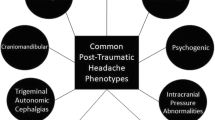Abstract
Traumatic brain injury (TBI) is highly prevalent in the United States and a common cause of posttraumatic headache (PTH) and disability. The criteria that define PTH include timelines and features that are not based on clearly established physiologic data and may result in the underrecognition and incorrect treatment of these headaches. A clear understanding of the classification of PTH becomes even more elusive when one takes into account combat-related head injuries, which are also highly prevalent and frequently lead to headaches with features that are different from those suffered by civilians with PTH. The fact that tensiontype headache phenotypes are uncommon in military personnel with PTH suggests that there are features unique to the combat environment, which may predispose to the development of migraine. Further insight may also be obtained from soldiers with PTH with regard to the true pathophysiology and timelines of headache in the context of TBI.
Similar content being viewed by others
References and Recommended Reading
Rasmussen BK, Jensen R, Schroll M, Olesen J: Epidemiology of headache in a general population: a prevalence study. J Clin Epidemiol 1991, 44: 1147–1157.
Dowson A, Dahlof C, Tepper S, et al.: The prevalence and diagnosis of migraine in a primary care setting. Cephalalgia 2002, 22: 590–591.
Headache Classification Subcommittee of the International Headache Society: The International Classification of Headache Disorders, 2nd edn. Cephalalgia 2004, 24: 1–160.
National Center for Injury Prevention and Control: Report to Congress on mild traumatic brain injury in the United States: steps to prevent a serious public health problem. Centers for Disease Control and Prevention. Available at http://www.cdc.gov/ncipc/pub-res/mtbi/mtbireport.pdf. Accessed August 2009.
Langlois JA, Rutland-Brown W, Thomas KE: Traumatic brain injury in the United States: emergency department visits, hospitalizations, and deaths. US Department of Health and Human Services, CDC; 2004. Available at http://www.cdc.gov/ncipc/pub-res/TBI_in_US_04/TBI%20in%20the%20US_Jan_2006.pdf. Accessed August 2009.
Gurr B, Coetzer BR: The effectiveness of cognitive behavioral therapy for post-traumatic headaches. Brain Inj 2005, 19: 481–491.
Thurman DJ: The epidemiology and economics of head trauma. In Head Trauma: Basic, Preclinical, and Clinical Directions. Edited by Miller L, Hayes R. New York: John Wiley and Sons; 2001.
Lenaerts ME: Post-traumatic headache: from classification challenges to biological underpinnings. Cephalalgia 2008, 28(Suppl 1): 12–15.
Theeler BJ, Erickson JC: Mild head trauma and chronic headaches in returning US soldiers. Headache 2009, 49: 529–534.
Lew HL, Lin PH, Fuh JL, et al.: Characteristics and treatment of headache after traumatic brain injury: a focused review. Am J Phys Med Rehabil 2006, 619–627.
Linder SL: Post-traumatic headache. Curr Pain Headache Rep 2007, 11: 396–400.
Walker WC, Seel RT, Curtiss G, Warden DL: Headache after moderate and severe traumatic brain injury: a longitudinal analysis. Arch Phys Med Rehabil 2005, 86: 1793–1800.
Bettucci D, Aguggia M, Bolamperti L, et al.: Chronic post-traumatic headache associated with minor cranial trauma: a description of cephalalgic patterns. Ital J Neurol Sci 1998, 19: 20–24.
Baandrup L, Jensen R: Chronic post-traumatic headache: a clinical analysis in relation to the International Headache Classification 2nd edn. Cephalalgia 2005, 25: 132–138.
Haas D: Traumatic-event headaches. BMC Neurol 2004, 4: 17.
Hoge CW, McGurk D, Thomas JL, et al.: Mild traumatic brain injury in U.S. soldiers returning from Iraq. N Engl J Med 2008, 358: 453–463.
Neely ET, Midgette LA, Scher AI: Clinical review and epidemiology of headache disorders in US service members: with emphasis on post-traumatic headache. Headache 2009, 49: 1089–1096.
Evans R: Posttraumatic headaches among United States soldiers injured in Afghanistan and Iraq. Headache 2008, 48: 1216–1225.
Author information
Authors and Affiliations
Corresponding author
Rights and permissions
About this article
Cite this article
Vargas, B.B. Posttraumatic headache in combat soldiers and civilians: What factors influence the expression of tension-type versus migraine headache?. Current Science Inc 13, 470–473 (2009). https://doi.org/10.1007/s11916-009-0082-1
Published:
Issue Date:
DOI: https://doi.org/10.1007/s11916-009-0082-1




